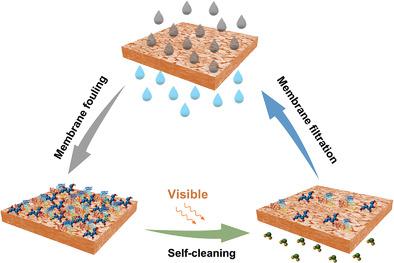当前位置:
X-MOL 学术
›
Adv. Funct. Mater.
›
论文详情
Our official English website, www.x-mol.net, welcomes your
feedback! (Note: you will need to create a separate account there.)
Visible‐Light‐Activated Photocatalytic Films toward Self‐Cleaning Membranes
Advanced Functional Materials ( IF 18.5 ) Pub Date : 2020-06-30 , DOI: 10.1002/adfm.202002847 Huiru Zhang 1, 2, 3, 4 , Anil U. Mane 5 , Xiaobin Yang 1, 4 , Zijing Xia 1, 4, 6 , Edward F. Barry 4, 5 , Jianquan Luo 2, 3 , Yinhua Wan 2, 3 , Jeffrey W. Elam 5 , Seth B. Darling 1, 4, 6
Advanced Functional Materials ( IF 18.5 ) Pub Date : 2020-06-30 , DOI: 10.1002/adfm.202002847 Huiru Zhang 1, 2, 3, 4 , Anil U. Mane 5 , Xiaobin Yang 1, 4 , Zijing Xia 1, 4, 6 , Edward F. Barry 4, 5 , Jianquan Luo 2, 3 , Yinhua Wan 2, 3 , Jeffrey W. Elam 5 , Seth B. Darling 1, 4, 6
Affiliation

|
Membranes are among the most promising means of delivering increased supplies of fit‐for‐purpose water, but membrane fouling remains a critical issue restricting their widespread application. Coupling photocatalysis with membrane separation has been proposed as a potentially effective approach to reduce membrane fouling. However, commonly used materials in photocatalysis limit use of low‐cost sources such as sunlight due to their large bandgaps. There are few examples of in situ photocatalytic self‐cleaning of membranes, with removal from the filtration system and ex situ illumination being more common. In this work, a visible‐light‐activated photocatalytic film prepared by nitrogen doping into the lattice of TiO2 is deposited on commercial ceramic membranes via atomic layer deposition. The synergy between membrane separation and redox reactions between organic pollutants and reactive oxygen species produced by the visible‐light‐activated layer offers a possibility for stable and sustainable membrane operation under in situ solar irradiation.
中文翻译:

可见光活化的光催化膜对自清洁膜的影响
膜是增加适应用途水供应的最有前途的手段之一,但膜结垢仍然是限制其广泛应用的关键问题。已经提出将光催化与膜分离耦合作为减少膜结垢的潜在有效方法。但是,光催化中常用的材料由于其带隙较大而限制了低成本光源的使用,例如阳光。膜的原位光催化自清洁的例子很少,从过滤系统中移出和异位照射更为常见。在这项工作中,通过将氮掺杂到TiO 2的晶格中制备了可见光激活的光催化膜。通过原子层沉积将其沉积在商业陶瓷膜上。膜分离与可见光活化层产生的有机污染物与活性氧之间的氧化还原反应之间的协同作用,为在原位太阳辐射下稳定,可持续地运行膜提供了可能性。
更新日期:2020-08-19
中文翻译:

可见光活化的光催化膜对自清洁膜的影响
膜是增加适应用途水供应的最有前途的手段之一,但膜结垢仍然是限制其广泛应用的关键问题。已经提出将光催化与膜分离耦合作为减少膜结垢的潜在有效方法。但是,光催化中常用的材料由于其带隙较大而限制了低成本光源的使用,例如阳光。膜的原位光催化自清洁的例子很少,从过滤系统中移出和异位照射更为常见。在这项工作中,通过将氮掺杂到TiO 2的晶格中制备了可见光激活的光催化膜。通过原子层沉积将其沉积在商业陶瓷膜上。膜分离与可见光活化层产生的有机污染物与活性氧之间的氧化还原反应之间的协同作用,为在原位太阳辐射下稳定,可持续地运行膜提供了可能性。











































 京公网安备 11010802027423号
京公网安备 11010802027423号